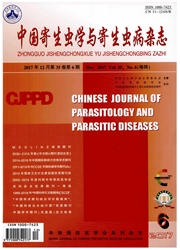

 中文摘要:
中文摘要:
目的 研究约氏疟原虫(Plasmodium yoelii)感染早期小鼠调节性T细胞(Treg)/辅助性T细胞17(Th17)比值变化。 方法 20只6~8周龄雌性BALB/c小鼠经腹腔注射1×106个约氏疟原虫17XL感染的红细胞,其中10只小鼠分别于感染前、后1 d注射1 mg CD25单克隆抗体(7D4),建立约氏疟原虫感染小鼠模型和Treg消除小鼠模型。于感染后1~7 d采小鼠尾静脉血,计数红细胞感染率,统计小鼠存活率。另取两模型组小鼠各10只,于感染前(0 d)、感染后3 d和5 d分别取3只小鼠脾组织,制备脾细胞悬液,流式细胞仪分别检测脾细胞中Treg和Th17数量占CD4+ T细胞的百分比,计算Treg/Th17比值,分析Treg数量百分比与Th17数量百分比的相关性。 结果 约氏疟原虫17XL感染后2 d,感染组小鼠外周血中出现疟原虫感染的红细胞;感染后5 d,红细胞感染率上升至(49.8±4.7)%,小鼠存活率降至60.0%(6/10);感染后6 d,小鼠全部死亡。Treg消除组小鼠也于感染后2 d外周血中出现疟原虫感染的红细胞,至感染后5 d红细胞感染率仅为(10.0±3.5)%,于感染后7 d上升至60.0%,感染后8 d小鼠全部死亡。感染后3 d,感染组小鼠Treg和Th17数量百分比分别为(11.1±1.3)%和(16.7±3.3)%,感染后5 d增加为(26.1±4.5)%和(19.6±2.6)%,均显著高于感染前[(5.0±0.7)%和(2.4±0.3)%](P<0.01);感染后3 d和5 d 的Treg/Th17比值分别为0.7±0.1和1.3±0.4,均低于感染前(2.1±0.5)(P<0.01,P<0.05);Treg消除组小鼠Treg和Th17数量于感染后3 d和5 d分别为(2.4±1.3)%、(4.3±2.9)%和(26.1±2.2)%、(6.5±2.1)%;Treg/Th17比值分别为0.1±0.1和0.7±0.4,均低于感染前(3.6±0.4)(P<0.01)。相关性分析结果显示,Treg数量百分比与Th17数量百分比呈正相关(r=0.8166,P<0.01)。 结论 约氏疟原虫17XL感染早期小鼠Tregs/Th17比值明显降低。
 英文摘要:
英文摘要:
Objective To investigate the change of Treg/Th17 cell ratio in mice infected with Plasmodium yoelii 17XL in the early stage of infection. Methods Forty 6-8 week-old female BALB/c mice were randomly divided into infection group and Treg blockade group. All the mice were infected by intraperitoneal injection with 1×106 P. yoelii 17XL-parasitized erythrocytes. Mice in Treg blockade group were intraperitoneally injected with 1 mg CD25 mAb before infection and on day 1 post-infection, respectively. Three healthy mice served as control. Tail vein blood samples were collected in two groups each with 10 mice during day 1-7 post-infection. The parasitemia was monitored daily by examining Giemsa-stained thin film. The survival rate of infected mice was calculated. Before infection, on day 3 and 5 post-infection, the spleen was aseptically removed from each mouse in infection group (n=3) and Treg blockade group (n=3), and splenocyte suspensions were prepared. The proportion of Treg and Th17 cells were analyzed by flow cytometry. The ratio of Treg/Th17 cells was calculated and the relative analysis of the percentage of Treg and Th17 cells was conducted. Results Parasitemia appeared on day 2 post-infection in infection group. On day 5, the infection rate of P. yoelii in erythrocytes increased to (49.8±4.7)% with a survival rate of 60.0%. All mice died on day 6 post-infection. In Treg blockade group, P. yoelii 17XL-parasitized erythrocytes appeared on day 2 post-infection; the parasitemia was(10.0±3.5)% on day 5, and increased rapidly to 60.0% on day 7; all mice died on day 8. The percentages of Treg and Th17 cells reached(11.1±1.3)% and (16.7±3.3) % respectively on day 3 post-infection in infection group, and increased to(26.1±4.5)% and (19.6±2.6) % on day 5, considerably higher than that of the control(P<0.01). The ratio of Treg/Th17 cells was 0.7±0.1, 1.3±0.4 on day 3 and 5 post-infection in infection group, respectively, which was much lower than that of
 同期刊论文项目
同期刊论文项目
 同项目期刊论文
同项目期刊论文
 期刊信息
期刊信息
